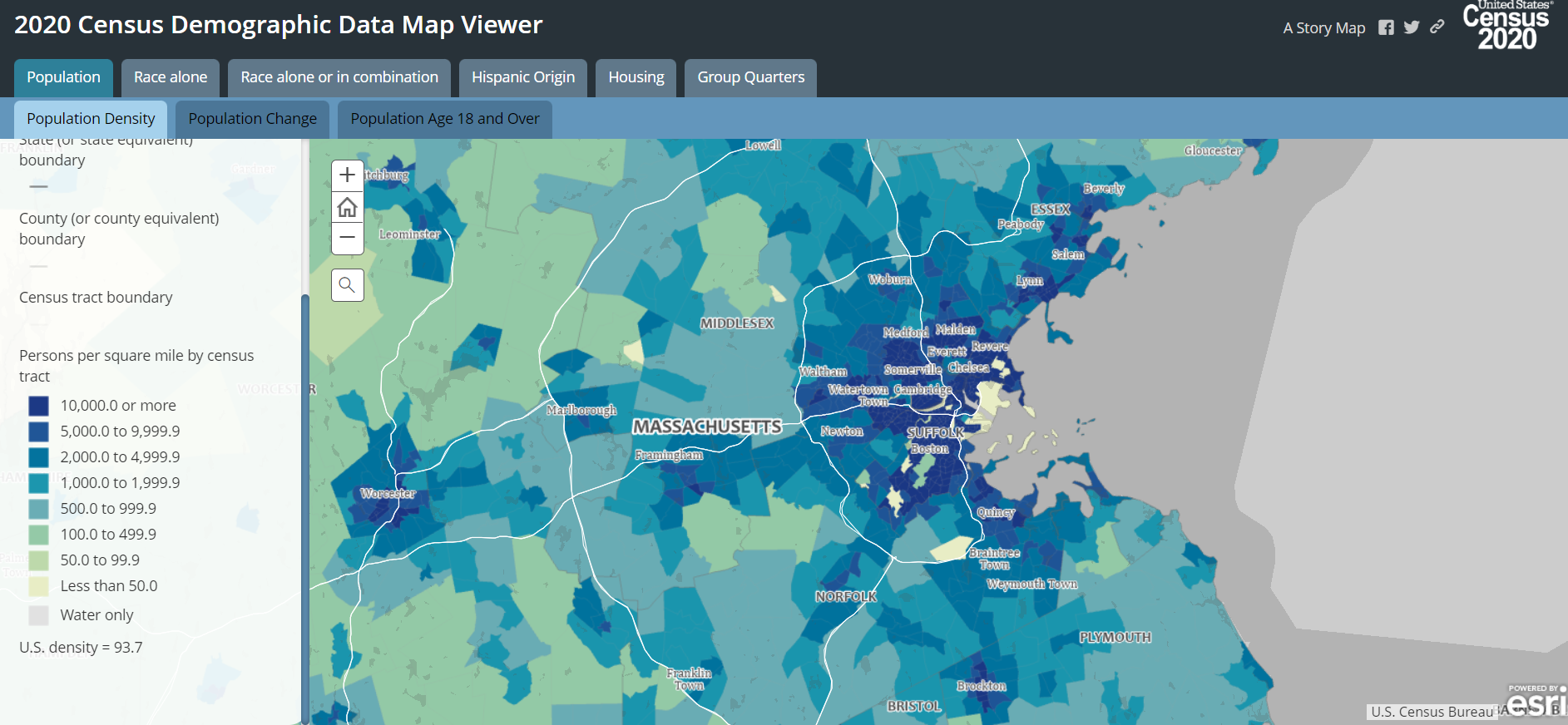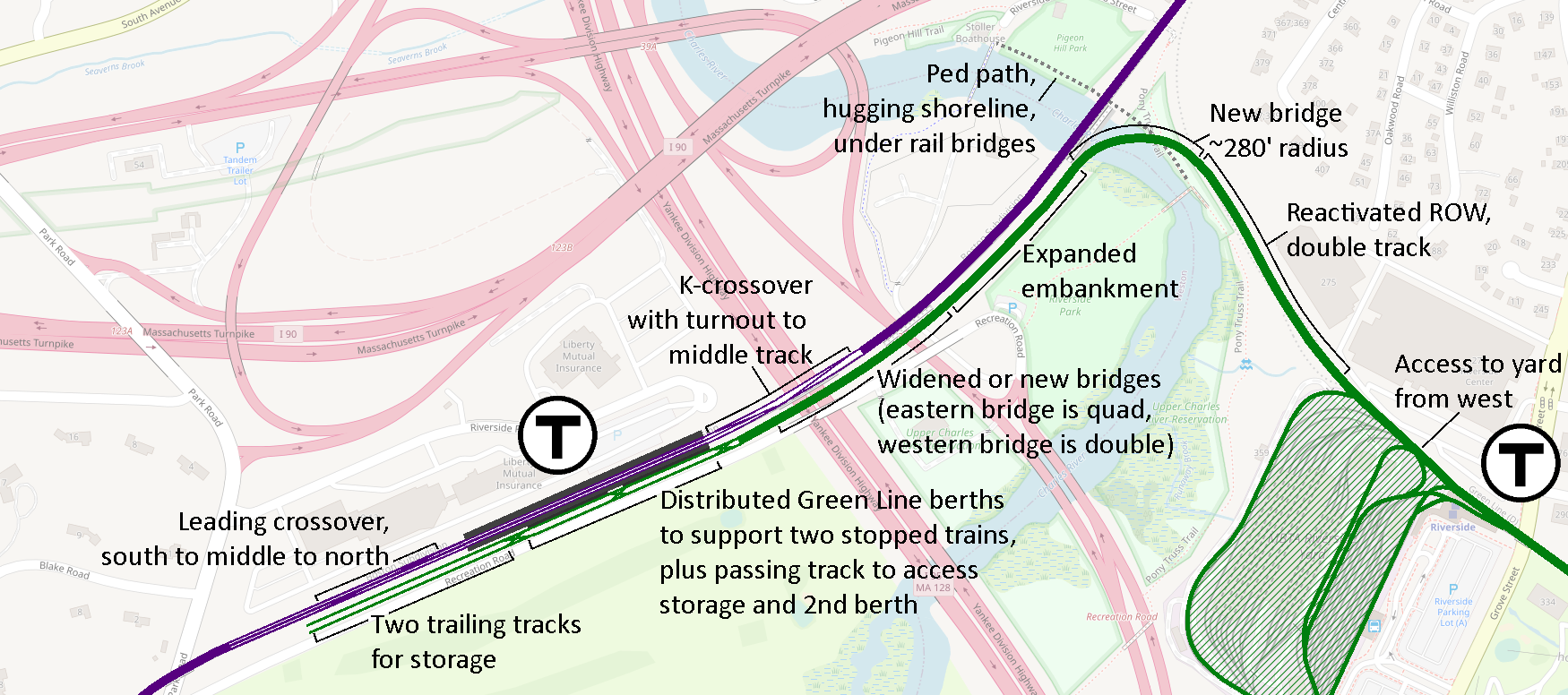Note: Since writing this, I have largely concluded that the best solution here is to keep the Green Line at Riverside, and either build a single Regional Rail platform there to accept 1-2 trains per hour (to provide short-turn service to increase frequency to the Newton commuter rail stations), or simply run increased frequencies all the way to Framingham, as discussed here.
We hope that sometime in the future there will be many more trains running on the Framingham/Worcester Line (the “B&A”) than there are today. We know this would be an effective way to provide transit to “the Newtons”, and it reflects an overall transformation toward Regional Rail. The “inner/mid B&A” is particularly friendly to more frequent rail, as most of the stops between 128 and Framingham have reasonable pedestrian access and/or potential for TOD.
In general, most of the proposals I’ve seen tossed around have assumed that one “layer” of service would be a short-turn service within 128, and I think most of us have figured that service would terminate on a spur at Riverside station. Historically, there was a platform on the B&A main line that was also called Riverside, but it was some 1,800 feet away from the Green Line station, and saw low ridership. (For comparison, Woodland is 3,000 feet away.)
Layering short-turn B&A services to provide high frequencies
I was crayoning Regional Rail service patterns on the B&A a while back and got to thinking. On other “Metro Rail” corridors (i.e. within 128), I’ve felt that it was reasonable to layer on the “longer distance” services on top of the short-turns to reach high frequencies, and have the longer distance trains make most/all local stops. With infrastructure improvements to reduce travel times, I’ve mostly felt that expressing through the inner stops was unnecessary. But for the B&A, I’m less confident. Given Worcester’s distance and the curvy route the tracks have to take through the hills, it seems possible that even in a Regional Rail world, we’ll still want some Worcester expresses.
For comparison, pre-covid most peak Worcester trains skipped both the “mid” stops in Wellesley, as well as the “inner stops” in Newton. And still took ~90 min to do so. Worcester is the commonwealth’s second largest city and by now is comfortably larger than Providence; it shouldn’t take 90 minutes to reach Boston. So I think express services need to remain under consideration. Therefore, I don’t want to rely on Worcester trains to increase the tph within 128 — it may not be necessary, but I’d like to have alternatives.
I also think it’s worth examining higher-frequency service to Wellesley, Natick, and Framingham. Though not as dense as the within-128 suburbs, there is a clear “arm” of density stretching west along Route 9. Moreover, most of the stations in those towns are located in well-built-up areas that are, or could be, friendly to frequent transit.

So, it might be possible that we’d want higher frequencies to the mid-B&A, and that we’d still want to reserve slots for expresses to the outer B&A. In principle, this could be done via 4 tph express to outer B&A, 4 tph local to Framingham, and an additional 4 tph turning at Riverside. There’s a lot that could work well about this, but that Riverside spur is a bit fragile and makes me nervous; if there were increased demand along the mid B&A, some of those Riverside trains probably be switched back over to the main line, which reduces Riverside Indigo frequencies below the 15-minute threshold. Once that happens, I think you’re at significantly higher risk for a ridership death spiral.
Now, it’s worth pausing for a second here, and noting that we are already pretty far down the rabbit hole here. I think an Indigo spur to Riverside, overall, makes sense, although I think there is also an argument for extending all those within-128 Metro trains to Framingham anyway.
But while we’re down this rabbit hole…
The way to maximize frequencies — under any scenario — to the Riverside area — i.e. to a P&R near 128 & Mass Pike — is to put the station on the mainline. That gives you access to both short-turns and to through-run trains for maximum frequencies. As mentioned before, a mainline station was tried, and wasn’t successful — poor walkshed, limited parking (I think), and difficult transfer to the Green Line.
Norumbega Junction
But what if, instead of extending the Indigo Line to meet the Green Line, we extended the Green Line to the mainline?
Thus, Norumbega Junction:

(Yes, it is true that “Norumbega” — insofar as it even is a real place — is about a mile to the northeast. But I couldn’t think of a more specific name, and tbh thought that “Norumbega Junction” sounded pretty cool, so that was that.)
Details
The Green Line is extended northwest from Riverside along the extant ROW toward the B&A. Instead of curving northeast to rejoin the B&A pointing toward Boston, the ROW is instead rerouted over a new bridge pointing west to rejoin the B&A on the opposite side of the Charles.
The embankment between the river and the off-ramp is (re-)expanded to support four trakcs, matching the historical width of the ROW. The overpass crossing the off-ramp is already quad-track width; the overpass crossing 128 would be (re-)widened or supplemented by a second bridge for the light rail tracks.
A new station would be constructed along the tangent track parallel to Recreation Road, in the stretch between 128 and Park Road, where the tangent stretch is amply long and the ROW is relatively wide and unencumbered. Per the designs of the Worcester Third Track project, a turnout just east of the station would enable a middle passing track; the interlocking design would be modified to also support reversing terminating trains at the station.
Mainline platforms would sit on the outer tracks; the southern platform would be shared by regional rail trains on the north side and light rail trains on the southside. The Green Line ROW would extend the length of the station, with double tracks the entire length, but only the northern track would have access to the platform; a pair of crossovers would instead create two “berths” along the platform to enable multiple Green Line trains to stop and reverse directions. The tangent stretch is long enough to also support a pair of tail tracks beyond the station for additional storage and reversing.
Riverside Yard would maintain its current role. The current track layout would enable yard access from the west with minimal modification. Extension through Riverside Park could also include additional beautification and pedestrian access measures.
Parking and automobile access
Not illustrated here is parking. There are two lots to the northeast of the station site — one is about 40,000 sq ft, and the other I believe is 50,000 sq feet, which is the footprint of the Woodland garage. So, in principle there’d be space for robust PnR, especially with a garage.
The biggest downside I’ve seen so far is that access from the highways is… mixed.
- Route 128 from the south: not bad — get off at Recreation Road and cross over
- Route 128 from the north: requires a jaunt on MA-30, which is okay not great
- Mass Pike from the west: kinda garbage — exit to MA-30 and double-back
- Mass Pike from the east: easy — off ramp directly to Park Rd
I think items 2 and 3 could be addressed via connections from ramps to Park Rd — from the eastbound Mass Pike off-ramp, and from the (very long) soutbound 128-to-90 off-ramp. But I’m woefully uninformed about highway engineering, so those may not work.
Benefits and shortcomings
So, what would Norumbega Junction help with? And what does it leave lacking?
Helps:
- Frequencies on mid-B&A
- Frequencies for a Metro short-turn service terminating at a Park-n-Ride
- Overall parking capacity at PnR stations in the area
- Reverse-commute options to Wellesley, Natick, Framingham and possibly Worcester, from Newton and Brookline
- Better transfers from Indigo to Green, potentially enabling more direct service to Longwood
- (definitely slower, but the speed penalty might get outweighed by a shorter walk from Longwood station than from Lansdowne)
- Opportunistic riders who currently drive to Riverside as one option among several
- providing additional parking
- maximum frequencies from a single platform — make a “game time” decision of boarding Indigo vs Green
- Avoids rebuilds at Riverside, including needing to fit a long 800 foot platform
- Due to the layout at Riverside, an Indigo Line platform would need to be a significant distance away from the current Green Line platform
Doesn’t help:
- Frequencies from Riverside station itself
- although faster journeys may still be possible via a double-back: Riverside -> Norumbega Jct -> points east on the Indigo
- TOD at Riverside
- Folks who walk/bike to Riverside, who would see the same number of trains
- though there are already a few different trails that could be upgraded — it would be about a 12 minute walk (and very pretty!) between the two stations, which would be too long for some, but could be possible for others
- Reverse commuters going to Riverside from Newtonville, Allston, Brighton, and other Indigo points east
- Though, again, they would likely have higher frequencies on Indigo and then be able to change to do a one-stop jog (or 12-minute walk) to Riverside
Alternatives
To be clear, this is in large part a solution in search of a problem. I think there is benefit to maximizing the number of trains that can serve a station in this area, and that points to a station on the B&A main line. I think that Riverside’s current layout is not super amenable to adding a commuter rail platform, and I think projected frequencies do sit in a liminal range where they easily can slip down a tier in usefulness.
But there are three obvious alternatives that all probably make more sense in the short/medium term.
- Extend the Green Line to Auburndale
- Requires less commuter rail construction and no new parking
- Provides Green-Indigo transfer
- Requires widening the underpass at the Pike
- Not sure how compatible would be with current plans for rebuilding Auburndale
- Doesn’t provide a good location for turning within-128 services
- Terminate Indigo revenue service at Auburndale, and use the spur to Riverside to turn
- Lowest build option for short-turned service
- Successfully provides higher-freq service to the Newtons
- But, does not provide capacity relief or freq increases to Riverside
- Would require a new interlocking between Auburndale and the Riverside spur, or would require Metro service to wrong-rail for a very long stretch (though I believe additional interlocking inside 128 are planned for capacity upgrades)
- Run all “Indigo” service all the way to Framingham
- Essentially a no-build option
- Reflects current BAU (business-as-usual) except for increased frequencies
- Provides no transfer to Green, and no relief at Riverside (other than possibly redirecting some riders who get dropped off at Riverside right now — presumably some of them are getting dropped off because they missed their CR train, or the schedule to their local CR stop is too infrequent)
I’m definitely not opposed to an Indigo spur to Riverside. But I think that Metro services on the inner B&A (Auburndale, West Newton, Newtonville, Newton Corner) is by far the higher priority than additional service to Riverside. So, if it becomes difficult/costly/delaying to build a mainline platform at Riverside, we shouldn’t let that sink the whole enterprise. And a station at “Norumbega Junction” could offer an alternative in the future.
(Plus, for real, I really do like the sound of that name!)
This page is adapted from content in a larger discussion at ArchBoston.
